The history of Texas cattle ranching is deeply entrenched within the history of the state.
Since the 15th century the economic and social identity of Texas has been formed by livestock
ranching … which continues today.
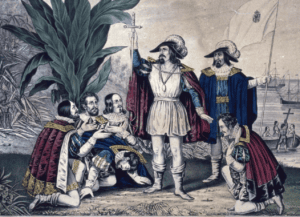 In 1493, on his second voyage to the new world, Christopher Columbus brought with him the first Spanish cattle. They were the predecessors of the Texas longhorn.The 16th and 17th centuries saw cattle raising spread north from Spanish Mexico into the area which is now Texas. The earliest migration of cattle was in the Rio Grande Valley. By 1680 there were thousands of cattle in the region.
In 1493, on his second voyage to the new world, Christopher Columbus brought with him the first Spanish cattle. They were the predecessors of the Texas longhorn.The 16th and 17th centuries saw cattle raising spread north from Spanish Mexico into the area which is now Texas. The earliest migration of cattle was in the Rio Grande Valley. By 1680 there were thousands of cattle in the region.
By mid-1700 private ranches were established by Spanish missionaries. The priest cared for the cattle making them the first Texas cattle ranchers. Cattle drives began during this time when livestock was driven to Louisiana to provide food for Spanish soldiers who were fighting the British during the American Revolution. By 1765, most of the Spanish missions were closed, the cattle left behind roamed freely and multiplied rapidly. Private citizens began rounding up the herds – these were known as Mesteño—meaning “ownerless”
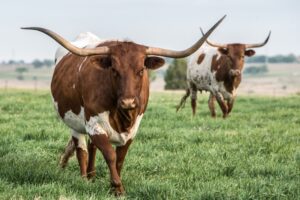
During the Mexican War for Independence from Spain (1810 to 1821), there was a major decline in the cattle market. At the end of the war, the Austin Colony (led by Stephen F. Austin) was established. Austin was given permission to settle 300 families on available land in the area. These families brought with them cattle from the eastern region of the United States.
Over time the eastern cattle bred with the Spanish cattle and the “beloved” Texas Longhorn was born. Cattle and beef production became a priority in this new settlement.
In the 1830’s, with the havoc of the Texas Revolution and the Mexican American War, large quantities of land and cattle were abandoned by Mexican ranchers. American settlers began to migrate into this abandoned area, settling in northern and western Texas. Over the next two decades the Texas ranching industry flourished. In 1845 Texas was annexed into the United States. Public land was distributed to build railroads and settlements. This increased new markets for Texas cattle. With the expansion of railways, Texas cattle were distributed to other parts of the country, including California, Missouri, Illinois, and Iowa. From there, beef was packed and distributed to markets in the northeastern states.
By the time the Civil War started in 1861, a huge demand for Texas beef had developed. Devastation in the south during the Civil War and the blockage of major shipping routes, like the. Mississippi River, created a large surplus of Texas cattle and a decreasing Southern demand for beef. At the same time, there was an increasing demand in the Northeast. By the end of the Civil War a steer, purchased in Texas for ten dollars, would be sold for thirty to forty dollars in the northeast.
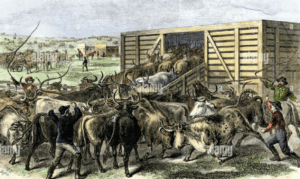
In 1867, the Kansas Pacific Railway established a stockyard and cattle market in Abilene, Kansas. This market was just outside of the state’s regulated quarantine area, along what would soon become the major route for driving Texas longhorns.
Since 1864, Jesse Chisholm had used a route to transport goods from Wichita to Indian camps
across the Southern Plains. The first cattle drive along this trail delivered over 2,000 cattle to
Abilene. The route would become known as the Chisholm Trail. It ran north from San Antonio to various Kansas settlements located at the intersections of trails and railroads along the trail. The Chisholm Trail was critical in bringing Texas cattle to markets in the North.
In 1870 there were nearly 15 million beef cattle nationwide.
By the late 1800’s, The Texas Longhorn was no longer the mainstay of the beef industry. This
was because of the lack of quality of the meat, tick-borne diseases that continued to spread
throughout the breed and increased restrictions on the transport of cattle between states. As
railroads expanded, the need for long drives was reduced. Longhorns’ sharp horns made it
difficult to transport them on tightly packed trains. Ranchers soon began crossbreeding them
cattle.
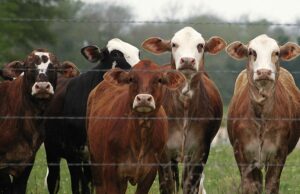 Long before Anglo American ranchers settled in Texas, vaqueros were herding and driving cattle and wild horses in the territory. The vaqueros were known for their skills. In the mid-1800’s Texas rancher Richard King began recruiting these men and their families to work on his ranch. They became known as Los Kinenos (King’s people). These vaqueros helped to make the King Ranch legendary. Richard King’s Ranch produced the Santa Gertrudis, which was the first authenticated U.S. cattle breed.
Long before Anglo American ranchers settled in Texas, vaqueros were herding and driving cattle and wild horses in the territory. The vaqueros were known for their skills. In the mid-1800’s Texas rancher Richard King began recruiting these men and their families to work on his ranch. They became known as Los Kinenos (King’s people). These vaqueros helped to make the King Ranch legendary. Richard King’s Ranch produced the Santa Gertrudis, which was the first authenticated U.S. cattle breed.
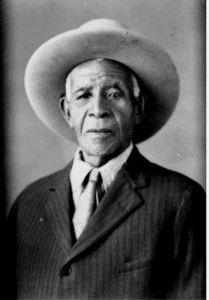
Early Texas cowhands also included many African Americans. Many were ex-slaves. These Mexican and African American cowboys handled most of the ranching labor. Following the emancipation, in 1865, many purchased lands of their own. The most famous of these was Daniel Webster Wallace. Wallace was born into slavery. After emancipation he worked for Texas rancher Clay Mann. Wallace would later purchase land and his own herds. When he died on March 28, 1939, he owned 16 properties and left an estate worth more than $1 million.
By 1880, the model of open ranges was changing due to overgrazing from trying to fulfill the
great demand for Texas beef. Texas ranchers began enclosing their land with barb wire fencing
as they attempted to find a balance between cattle production and protecting grass lands.
At the time, meat processors in Chicago controlled the beef market. Several attempts were
made to build packing/refrigeration plants in Texas but these failed. In order to combat the
market influence that the Chicago firm possessed, the National Live Stock Association and
American Stock Growers’ Association merged in 1906 to become the American National Live
Stock Association. As a result of the Associations efforts, in 1921, the Packers and Stockyards
Act was passed. This Act ensured fair competition for ranchers, farmers, and consumers by
regulating payment, investigating fraudulent practices, and prohibiting monopolies within the
livestock industry. This was necessary to preserve Texas’ ranching future!
Over time the expenses of owning and operating cattle ranches have greatly increased. Ranch owners have found other ways to use their property to cover escalating costs. These included oil and gas production, solar and wind farms, conservation efforts, and opening their land up for recreation purposes.
Despite the increase of people moving to the Long Star state and the need for metropolitan
areas to expand, the Texas cattle ranching legacy continues to live on. Today, Texas is #1 in
beef production in the United States. There are more than 240,000 farms and ranches
accounting for over 130 million acres of land in Texas. Texas has the 14th largest cattle
inventory in the world. In fact, the cattle population in Texas is larger than the population of
people in 43 of the other states.
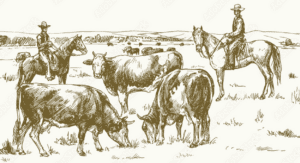
Texas Ranching has been romanticized in movies, songs, novels, paintings, and poetry.
The reality of life on the range was one full of hardships, loneliness, long rides in extreme
weather, fighting hostile predators and cattle rustlers.
“Other states were carved or born……Texas grew from hide and horn.”
Berta Hart Nance (Texas poet)
Ranch Connection is a full service Land and Ranch Real Estate Brokerage established in 1984.
If we can assist you with selling or buying a ranch/land please contact us at cynthia@ranchconnection.com
Please visit our website at www.ranchconnection.com
By: Dave Norris – davenorris@ranchconnection.com
